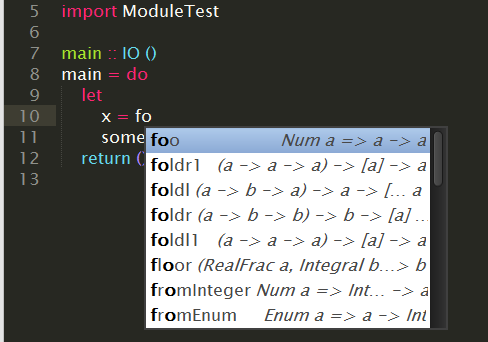Updated SublimeHaskell
A small update for SublimeHaskell .
The picture for the seed, the list of changes under the cutout.

The picture above shows that in the auto-completion list you can now see the type (or arguments in the case of a class or data type). Unfortunately, the width is limited, so not everything fits.
Now he is able to collect documentation for definitions in the module. Also collects more information about types, classes, etc.
Functions without explicitly specifying a type are now also supported, and their type is determined using ghc-mod / hdevtools.
The command shows the available information about the symbol: type (for the function) or context and arguments for data types and classes; the module where the symbol is defined; accessible documentation (both from source and with haskell-docs for modules in cabal); file and project where the symbol is defined.
The command is available by the combination of Ctrl-K Ctrl-I and also in the context menu, as well as go to declaration.

foo is described without specifying a type; type is inferred
The command is similar to that in ghci, displays the contents of the module, shows more detailed information about the selected item. The command is also called using the combination Ctrl-K Ctrl-I, if the cursor is on the module name.

Listed types and documentation are listed.
For successful work, I had to finish ghc-mod a bit by adding the --detailed flag for the browse command. Now more complete information is displayed:
Now hdevtools is used, which works quickly due to the fact that it hangs in the background, the 'Show Type' command has been redesigned and now looks like this:

The first in the list is replicate, since the cursor is on it.
hdevtools is not built on Windows, as it has unix dependencies, here you can download a fork running on Windows
The plugin now works with Sublime Text 3.
Also, very primitive caching was added, which significantly accelerated the start time.
The picture for the seed, the list of changes under the cutout.

The picture above shows that in the auto-completion list you can now see the type (or arguments in the case of a class or data type). Unfortunately, the width is limited, so not everything fits.
ModuleInspector
Now he is able to collect documentation for definitions in the module. Also collects more information about types, classes, etc.
Functions without explicitly specifying a type are now also supported, and their type is determined using ghc-mod / hdevtools.
Show symbol info
The command shows the available information about the symbol: type (for the function) or context and arguments for data types and classes; the module where the symbol is defined; accessible documentation (both from source and with haskell-docs for modules in cabal); file and project where the symbol is defined.
The command is available by the combination of Ctrl-K Ctrl-I and also in the context menu, as well as go to declaration.

foo is described without specifying a type; type is inferred
Browse module
The command is similar to that in ghci, displays the contents of the module, shows more detailed information about the selected item. The command is also called using the combination Ctrl-K Ctrl-I, if the cursor is on the module name.

Listed types and documentation are listed.
ghc-mod
For successful work, I had to finish ghc-mod a bit by adding the --detailed flag for the browse command. Now more complete information is displayed:
> ghc-mod browse -d Data.Either
Left
Right
data Either a b
either :: (a -> c) -> (b -> c) -> Either a b -> c
lefts :: [Either a b] -> [a]
partitionEithers :: [Either a b] -> ([a], [b])
rights :: [Either a b] -> [b]
hdevtools: show type
Now hdevtools is used, which works quickly due to the fact that it hangs in the background, the 'Show Type' command has been redesigned and now looks like this:

The first in the list is replicate, since the cursor is on it.
hdevtools is not built on Windows, as it has unix dependencies, here you can download a fork running on Windows
Sublime text 3
The plugin now works with Sublime Text 3.
Also, very primitive caching was added, which significantly accelerated the start time.
